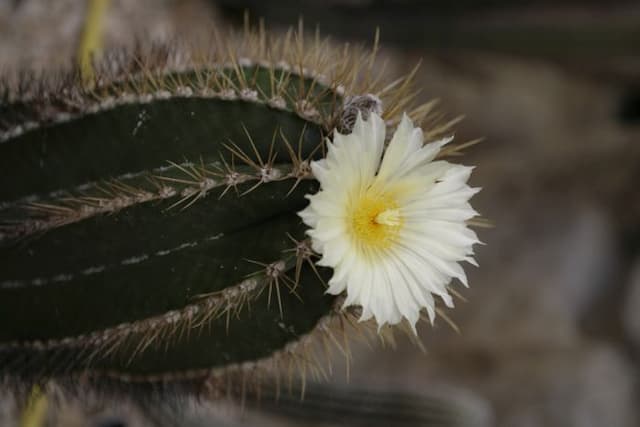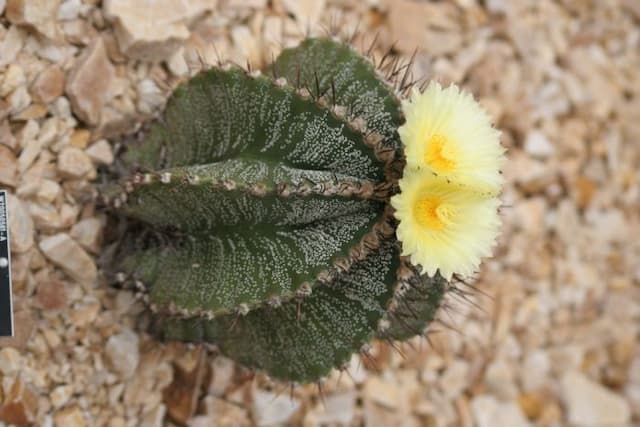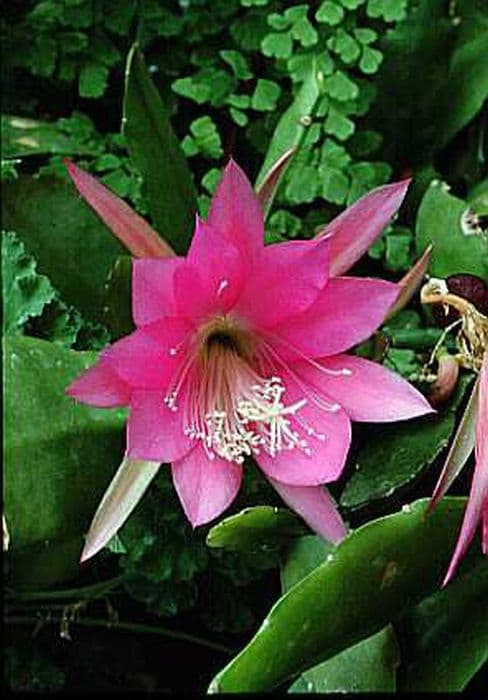Backeberg's Hedgehog Cactus Echinopsis backebergii subsp. backebergii

ABOUT
The plant in question is commonly known as Backeberg's cactus. It is known for its spherical to columnar shape, which typically makes it a distinctive presence. The surface of the cactus is a vibrant green, and it is covered with numerous rib-like protrusions that run vertically along its body. These ribs are adorned with areoles, which are small, cushion-like structures from which spines and flowers emerge. The spines can vary in color from yellow to brown, and they form a protective barrier that can be quite sharp to the touch. During its blooming season, the cactus produces flowers that are particularly striking. These blossoms can be quite showy, with a funnel-shaped structure and petals that might display colors ranging from red to orange, or sometimes even a combination thereof. The petals are often arranged in multiple rows, creating a flamboyant and attractive display. When not in bloom, the cactus reverts to its green state, with its spines offering a stark contrast to its otherwise smooth appearance. This cactus does not produce any sizeable leaves, adhering to its cactus nature of being a succulent with a focus on water storage within its thick and fleshy body, which helps it to survive in arid environments.
About this plant
 Names
NamesFamily
Cactaceae.
Synonyms
Backeberg's Cactus, La Paz Cactus, Cactus cola de zorro.
Common names
Lobivia backebergii, Trichocereus backebergii, Echinopsis backebergii.
 Toxicity
ToxicityTo humans
The Peruvian Torch cactus, also known as Echinopsis backebergii subsp. backebergii, is not commonly known for being toxic to humans when touched or handled. However, this cactus, like other Echinopsis species, contains psychoactive alkaloids, including mescaline. Mescaline is a hallucinogenic compound that can lead to altered states of consciousness if ingested. The consequences of ingesting parts of the Peruvian Torch cactus can include nausea, vomiting, increased heart rate, changes in vision, and psychedelic experiences. The consumption of this cactus for its psychoactive effects should be approached with caution and awareness of legal restrictions in some jurisdictions.
To pets
The Peruvian Torch cactus is not specifically known to be toxic to pets when simply touched or in proximity. However, ingestion of cactus spines can cause physical injury, and the psychoactive compounds, such as mescaline, present in the cactus can have detrimental effects on pets. If pets consume parts of this cactus, they may experience symptoms such as vomiting, diarrhea, disorientation, and difficulty moving. Due to the potential hazards, it is crucial to keep this plant out of reach of pets to prevent ingestion and ensure their safety.
 Characteristics
CharacteristicsLife cycle
Perennials
Foliage type
Evergreen
Color of leaves
Green
Flower color
Varies
Height
1-2 feet (30-60 cm)
Spread
1-2 feet (30-60 cm)
Plant type
Cactus
Hardiness zones
8
Native area
South America
Benefits
 General Benefits
General Benefits- Ornamental value: The plant, commonly known as Backeberg's cactus, has visually striking flowers which add aesthetic appeal to gardens, terrariums, and indoor displays.
- Drought-tolerant: Backeberg's cactus is well-suited for xeriscaping and drought-prone areas due to its low water requirements.
- Low maintenance: This cactus variety requires minimal care, making it an ideal choice for beginner gardeners or those with busy lifestyles.
- Pollinator attraction: The bright and large flowers of Backeberg's cactus can attract pollinators such as bees and hummingbirds, promoting biodiversity.
- Soil conservation: Being a cactus, it helps prevent soil erosion in arid landscapes due to its root system which helps to stabilize the soil.
- Educational interest: Backeberg's cactus can be used for educational purposes, such as teaching about plant adaptation and desert ecosystems.
 Medical Properties
Medical PropertiesThis plant is not used for medical purposes.
 Air-purifying Qualities
Air-purifying QualitiesThis plant is not specifically known for air purifying qualities.
 Other Uses
Other Uses- Echinopsis backebergii, commonly known as Backeberg's cactus, can be used in topiary art to create living sculptures due to its interesting shape and varied growth patterns.
- The spines of Backeberg's cactus can be used in tiny brushes or as needles in traditional crafts for their rigidity and sharpness.
- In some cultures, the cactus is planted as a protective barrier around properties because of its spiky exterior which can deter animals and intruders.
- This cactus is often used in photography and artistic compositions for its aesthetic appeal and the contrast it provides in desert landscapes.
- Backeberg's cactus may be used in educational settings to teach students about xerophytic plants and their adaptations to arid environments.
- The flowers of the cactus can be used in the floristry industry when in bloom, though this is a temporary use as Echinopsis flowers are short-lived.
- As part of drought-tolerant landscaping, Backeberg's cactus contributes to water conservation efforts in garden design.
- The cactus can be a source of inspiration for fashion and textile designs, reflecting its unique patterns and form.
- Backeberg's cactus, being native to high altitudes, can be studied for its ability to withstand UV radiation, potentially informing protective coatings or materials.
- The cactus’s rapid night-time flowering can be a draw in nocturnal gardens or for night-time garden events.
Interesting Facts
 Feng Shui
Feng ShuiThe Lobivia is not used in Feng Shui practice.
 Zodiac Sign Compitability
Zodiac Sign CompitabilityThe Lobivia is not used in astrology practice.
 Plant Symbolism
Plant Symbolism- Resilience: Echinopsis backebergii, commonly known as the Backeberg's cactus, must withstand harsh, arid environments; hence, it symbolizes the ability to endure and thrive under tough conditions.
- Protection: The sharp spines of the Backeberg's cactus serve as a natural defense mechanism, representing protection and self-guardianship.
- Adaptability: This cactus has adapted to thrive in high sun exposure and low water conditions, symbolizing adaptability and flexibility in life's circumstances.
- Beauty and Astonishment: With its strikingly beautiful blooms that can appear suddenly, the Backeberg's cactus reminds us of the unexpected beauty in the world and its ability to surprise and captivate us.
 Water
WaterLobivia backebergii requires moderate watering during the growing season; typically, this means watering every 7-10 days. It's best to allow the soil to dry out completely between waterings to mimic the natural arid conditions the plant is accustomed to. Provide enough water to soak the soil thoroughly, which might be around 8-16 ounces for smaller pots. During winter, reduce watering to once a month or whenever the soil becomes completely dry, since the plant is dormant and uses less water.
 Light
LightLobivia backebergii thrives best in bright, indirect sunlight. It should be placed in a location where it can receive plenty of light without being exposed to the harsh, direct afternoon sun. An east or west-facing window is typically ideal, providing the cactus with the bright morning or evening sun while protecting it from intense midday rays.
 Temperature
TemperatureLobivia backebergii does well in temperatures between 50 to 80 degrees Fahrenheit. The cactus can withstand short periods of colder weather and survive temperatures as low as 30 degrees Fahrenheit, but it should not be exposed to frost. Similarly, extremely high temperatures above 90 degrees Fahrenheit should be avoided if possible to prevent heat stress.
 Pruning
PruningPruning is not commonly required for Lobivia backebergii, but if necessary, it can be done to remove dead or damaged spines and to maintain the plant's shape. The best time for pruning is in the spring, just before the growing season begins, and should be performed sparingly, using tweezers or gloves to avoid injury from the spines.
 Cleaning
CleaningAs needed
 Soil
SoilThe best soil mix for the Peruvian Apple Cactus should be well-draining with a mix of regular potting soil, perlite or pumice, and coarse sand. The ideal pH level for this soil mix is slightly acidic to neutral, ranging from 6.0 to 7.5 for optimal growth.
 Repotting
RepottingPeruvian Apple Cactus should be repotted every 2 to 3 years or when it has outgrown its pot. Younger plants may require more frequent repotting, while mature specimens can be repotted less often.
 Humidity & Misting
Humidity & MistingPeruvian Apple Cactus thrives in low humidity conditions typical of arid environments. High humidity is not required and can lead to fungal issues.
 Suitable locations
Suitable locationsIndoor
Place in bright, indirect light and avoid overwatering.
Outdoor
Full sun to partial shade; protect from excessive moisture.
Hardiness zone
9-11 USDA
 Life cycle
Life cycleThe life cycle of Echinopsis backebergii subsp. backebergii, commonly known as Backeberg's cactus, begins with germination, which occurs when its small, black seeds are sown in well-draining soil and exposed to warm temperatures. Following germination, the seedling stage is characterized by the development of a small, globular cactus body with areoles from which spines emerge. As the cactus matures, it enters a vegetative growth phase, during which it develops its distinctive ribbed, cylindrical shape and may produce offsets or pups around its base. Once mature, which can take several years, Backeberg's cactus begins its reproductive stage, blooming annually with large, colorful flowers typically during spring or early summer, depending on climatic conditions. After pollination, which is often aided by insects or sometimes by the wind, the flowers develop into fruit that contains seeds, thus enabling propagation. The plant can live for many years, flowering repeatedly each season, as long as it receives appropriate care including ample sunlight and minimal water.
 Propogation
PropogationPropogation time
Spring-Early Summer
The Lobivia cactus, more formally known as Echinopsis backebergii subsp. backebergii, is commonly propagated by seeds or by separating offsets, which are the small cacti that grow at the base of the parent plant. To propagate by offsets, the most popular method, one should wait for the offset to form a callous after being removed from the main plant, which usually takes a few days. Once this occurs, the offset can be placed on well-draining cactus soil and kept in a warm, bright environment, but out of direct sunlight, to encourage root development. Watering should be minimal and only done once the soil is completely dry, to avoid rotting the new roots. This particular method is best done during the active growing season, which is typically the warmer months from late spring to early fall.









